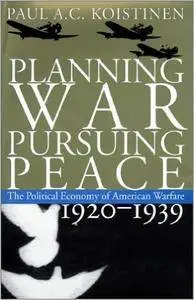Planning War, Pursuing Peace: The Political Economy of American Warfare, 1920-1939 (Modern War Studies) by Paul A. C. Koistinen
1998 | ISBN: 0700621156, 0700608907 | English | 466 pages | EPUB | 0.5 MB
1998 | ISBN: 0700621156, 0700608907 | English | 466 pages | EPUB | 0.5 MB
In the years following World War I, America's armed services, industry, and government took lessons from that conflict to enhance the country's ability to mobilize for war. Paul Koistinen examines how today's military-industrial state emerged during that period—a time when the army and navy embraced their increasing reliance on industry, and business accelerated its efforts to prepare the country for future wars.
Planning War, Pursuing Peace is the third of an extraordinary five-volume study on the political economy of American warfare. It differs from preceding volumes by examining the planning and investigation of war mobilization rather than the actual harnessing of the economy for hostilities; and it is also the first book to treat all phases of the political economy of wartime during those crucial interwar years.
Koistinen first describes and analyzes the War and Navy Departments' procurement and economic mobilization planning-never before examined in its entirety-and conveys the enormity of the task faced by the military in establishing ties with many sectors of the economy. He tells how the War Department created commodity committees to carry on the work of World War I's War Industries Board, and how both military and industrial powers strove to protect their mutual interests against those seeking to avoid war and to reform society.
Koistinen then describes the American public's struggle to come to terms with modern warfare through the in-depth explorations of the work of the House Select Committee on Expenditures in the War Department, the War Policies Commission, and the Senate Special Committee Investigating the Munitions Industry. He tells how these investigations alarmed pacifists, isolationists, and neo-Jeffersonians, and how they led Senator Gerald Nye and others to warn against the creation of "unhealthy alliances" between the armed services and industry.
Planning War, Pursuing Peace clearly shows how the U.S. economy was both directly and indirectly planned based on knowledge gained from World War I. By revealing vital and previously unexplored links between America's World Wars, it further illuminates the political economy of twentieth-century warfare as a complex and continually evolving process.



